Headphone amplifier based on the LME49710 + LT1210CT7 composite circuit
Some lyrics
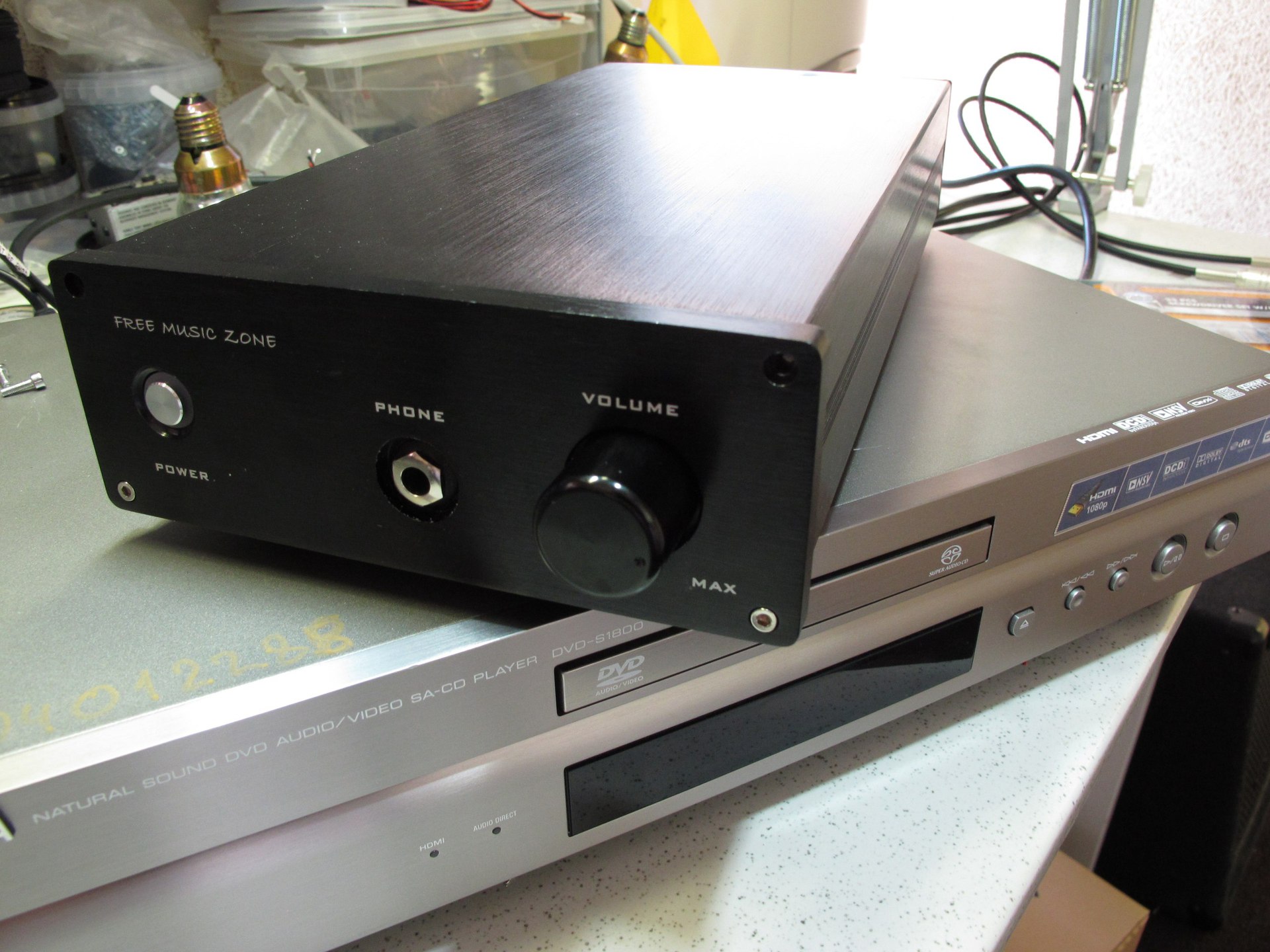
By the nature of my activity, I constantly communicate with professional audio equipment, so the goal of this development was to get a device with high fidelity playback. Therefore, circuit design solutions without environmental protection were immediately discarded and a composite circuit with great potential was taken as the basis. It was necessary to meet several devices with such a topology, however, in most designs, LT1795 or AD815 devices were used. However, as Dmitry Andronnikov (aka Lynx) mentioned in one of his articles:
even very powerful op amps with TOC when connected to their output headphones with resistances below 50 ... 60 ohms work in a rather intense mode both in output current (which leads to an increase in distortion) and in heat release.
It was decided to attract "heavy artillery," but more on that below.
Now the device
Nutrition
I will begin, perhaps, from the very end: the first support stronghold is a network noise filter and snubber in the secondary windings of the transformer. The objective of the snubber is to extinguish the parasitic oscillatory process in the circuit formed by the leakage inductance of the transformer and the capacitance of the circuit of its secondary winding at the moments when the diodes are locked. The task of determining the parasitic parameters of transformers is very nontrivial, therefore, studies by Alexey (Lexus) were used and nominal values of 100 Ω and 0.1 μF were established.
Initially, I intended to install a two-tier LC filter using chokes made by Murata of the PLA10 and PLH10 series; EMF suppression capacitors - Epcos X2 with a capacity of 0.22 microfarads and an Epcos S20K275 varistor with a high absorbed energy of 150 J.
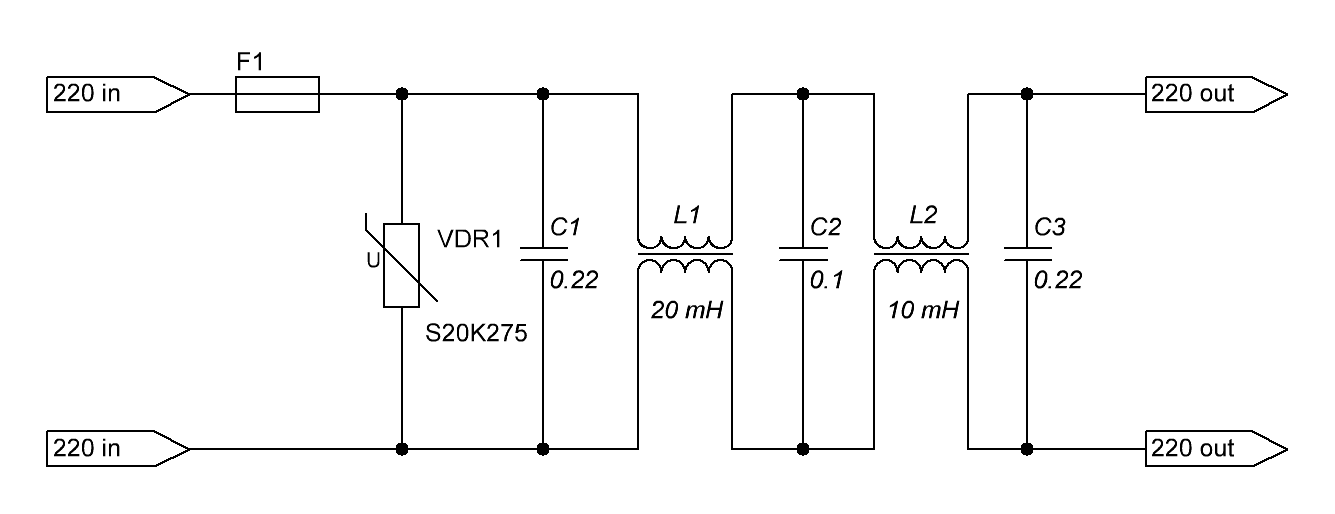
But in the end it was decided to use ready-made solutions in order to save space in the case:
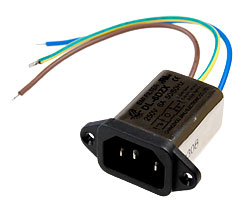
Mitsubishi Electronic's M5230L instruments were used as stabilizers [5]. Quite interesting devices that have very low intrinsic noise (many times smaller than the widely used LM317 / LM337) in a wide frequency range: 12 µV RMS, 20 Hz - 100 kHz, high temperature stability (0.01% / ° ). But there is one minus - the output current of the IC itself is limited at the level of 30 mA, so it is necessary to use external control transistors to obtain large currents. The circuit of inclusion has no features and is taken from the High ripple rejection circuit. Regulating transistors are applied 2SC4793 / 2SA1837 and installed on a common radiator.
')
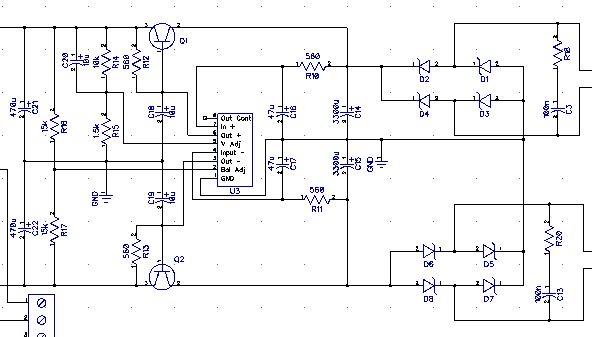
SMD Schottky 10MQ100 diodes are used as rectifier. 3300 uF Panasonic FC capacitors, the rest are Elna Silmic and Silmic II series. Initially, it was planned to install additional tanks near LT1210, but already when distributing the board, it was decided to refuse them, since the output capacities of the power supply were in close proximity to the consumer. When using Elna capacitors at the design stage of a printed circuit board, it is necessary to clarify their dimensions on the manufacturer's website, since these capacitors have several times larger dimensions than “ordinary” ones:
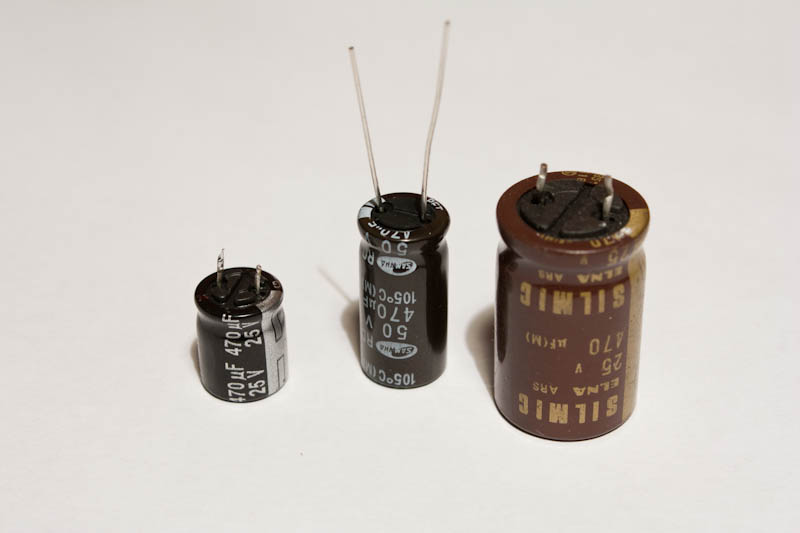
Amplifier
The composite circuit has a large loop gain, the output cascade on a powerful opamp is covered by its own operating system loop, which makes it possible to obtain fairly low distortions when working on various types of loads.

In the output stage, high-speed op amps are used with Linear current operating system LT1210CT7 in the TO220 package, which provides much better heat dissipation than the other package options offered by the manufacturer. These opamps can provide a long-term current of 1.1A (2A in peak), which makes it easy to work on a load with low resistance. The gain of the output opamp is 2, but can easily be reduced to 1, or increased. The choice of resistor values in the OS circuit of an OS with a TOC is somewhat more complicated than for an OS with a voltage OS: the stability of the circuit directly depends on its nominal. Decreasing the nominal value of Rf increases the working frequency band, but worsens the stability, decreasing it increases the stability and narrows the working range. The resistors in the OC circuit (1.5 kΩ) are selected in such a way as to ensure maximum stability. Compensation capacitors (C4, C23) provide stability when operating under a capacitive load. In general, the manufacturer promises stable operation at a capacitive load of up to 10,000 pF!

It is a little about the thermal mode. The datasheet [3] shows (which is not very often seen) examples of calculations of the thermal regime. The microcircuits are installed on individual HS211 radiators with a thermal resistance of 7.5 ° C / W. The thermal resistance of the crystal-case is 5 ° C / W. Without knowing the exact thermal resistance of the insulating gasket, it was taken for calculations 2 ° C / W (according to some data found on the Internet).
With a load of 16 Ohm (although professional headphones rarely have a resistance below 50-60 Ohms) and an output signal of 4V RMS (which corresponds to 5.6V amplitude voltage), the microcircuit will dissipate 2W of heat (current consumption in this mode is just over 100 mA). At an ambient temperature of 25 ° C, the crystal will heat up to 65 ° C.
Since our device will be located in a closed case, the temperature inside can reach quite decent values of 50-60 ° C. As a result, we obtain a crystal temperature of the order of 100-110 ° C, which is quite acceptable. But this is on a sinusoidal signal, on a musical signal (although it was necessary to “see” phonograms with RMS -3 db :-)) the heating will be much less.
The first “stage” was selected by a device manufactured by another company - LME49710 from Texas Instrument [4], which has excellent characteristics: a low level of all types of distortion, a very low noise level (0.34 µV RMS @ 20 Hz - 20000 Hz), a low level bias (± 0.05 mV), large open-loop gain (140 dB) and high CMRR and PSRR (120 and 125 dB).
However, in the process of setting up the device, one copy of this OU came across, when installed, the constant output voltage was about 14 mV; after some deliberation, another device was installed (out of 10 purchased) - everything returned to normal.
Fee as an element of construction
When using such a high-speed opamp as the LT1210, which has a slew rate of 900 V / μs output voltage, special attention should be paid to the topology of the printed circuit board, since in high-speed analog circuits it can significantly affect the quality of the device. The fee must be designed to minimize the effect on the operation of the circuit. More information about the topology of printed circuit boards can be found in the books [1] and [2].
The amplifier is made on a double-sided printed circuit board, the lower layer of which is reserved for the GND polygon, of course, in the process of routing, some circuits still appeared on the lower layer, but they are short in length. This board topology was chosen to maximize the impedance of the earth, which is necessary for the stable operation of high-speed op amps. The vulnerability of the inverting inputs of the Shelter to the capacitance to the ground was also taken into account, since even a 1 pF capacitance can lead to an increase in the OU transmission coefficient at frequencies close to the maximum. The most obvious solution to this problem is to reduce the length of the conductor. Another, less obvious, is a reduction in its width. As a result, the use of conductors with a thickness of 0.3 mm to the inverter input of an op-amp gives a capacity of about 0.1 pF depending on the dielectric constant of the board material (for FR-4, from 4 to 5).

In the process of assembly and configuration
The device is powered by a transformer with four secondary windings with a voltage of 14 V and a current of 500 mA, which was specially ordered from the factory for this project. I used the ALPS RK27 10 kOhm volume control. The hull was purchased in China.


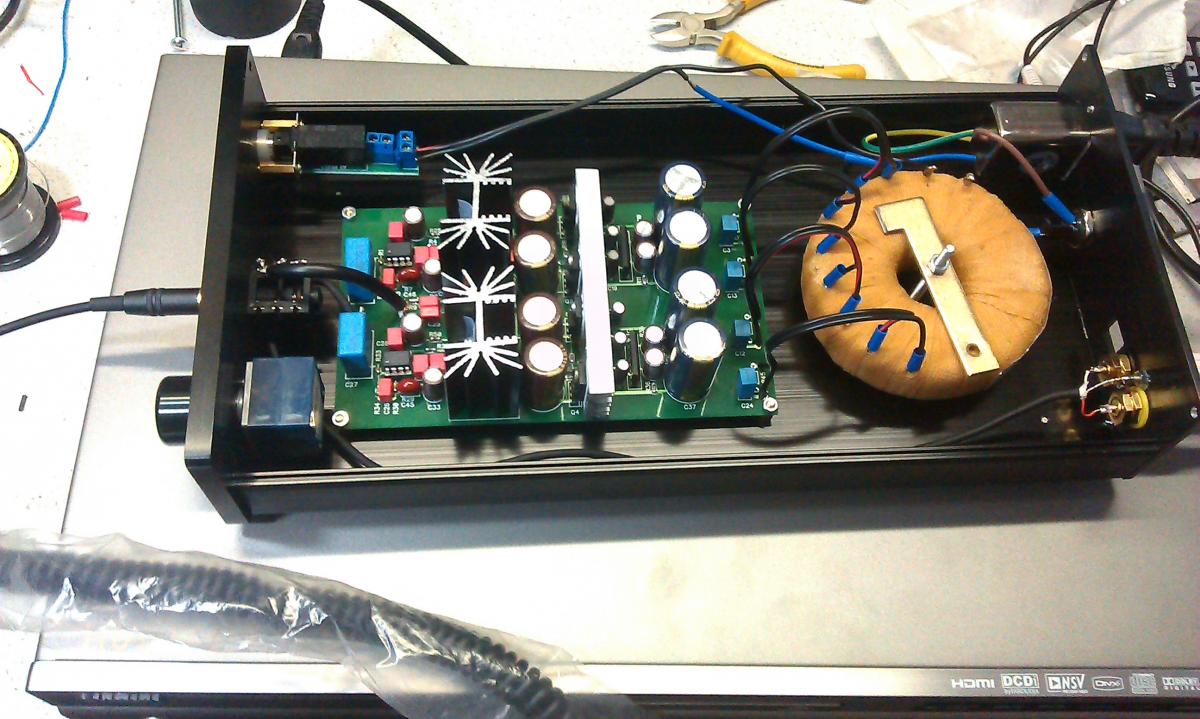
Unfortunately, at this moment, nothing but a telephone was available.
And now measurements
After assembly and listening, measurements were performed using the Audio Precision AP586 complex :



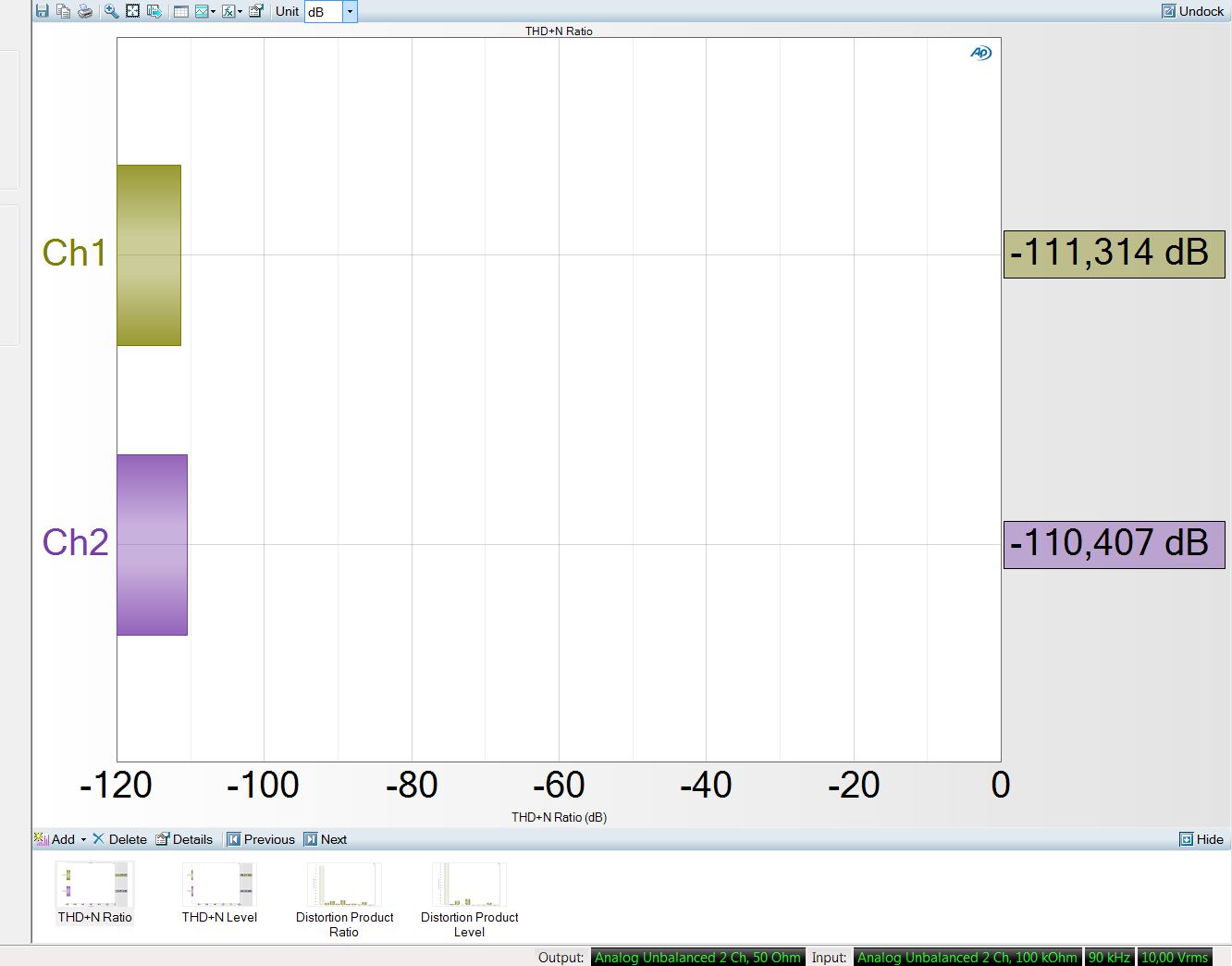

Literature:
- Bruce Carter and Ron Mancini. "Operational Amplifiers for All."
- Walt Jung. Op Amp Applications Handbook
- LT1210 datasheet
- LME49710 datasheet
- M5230L datasheet
Source: https://habr.com/ru/post/185074/
All Articles